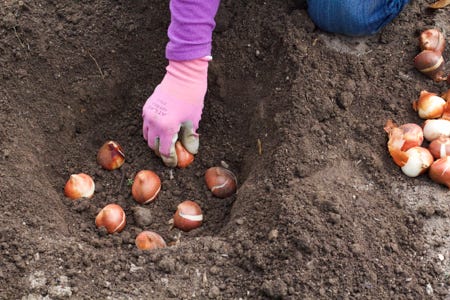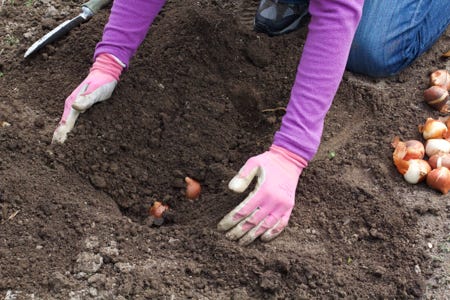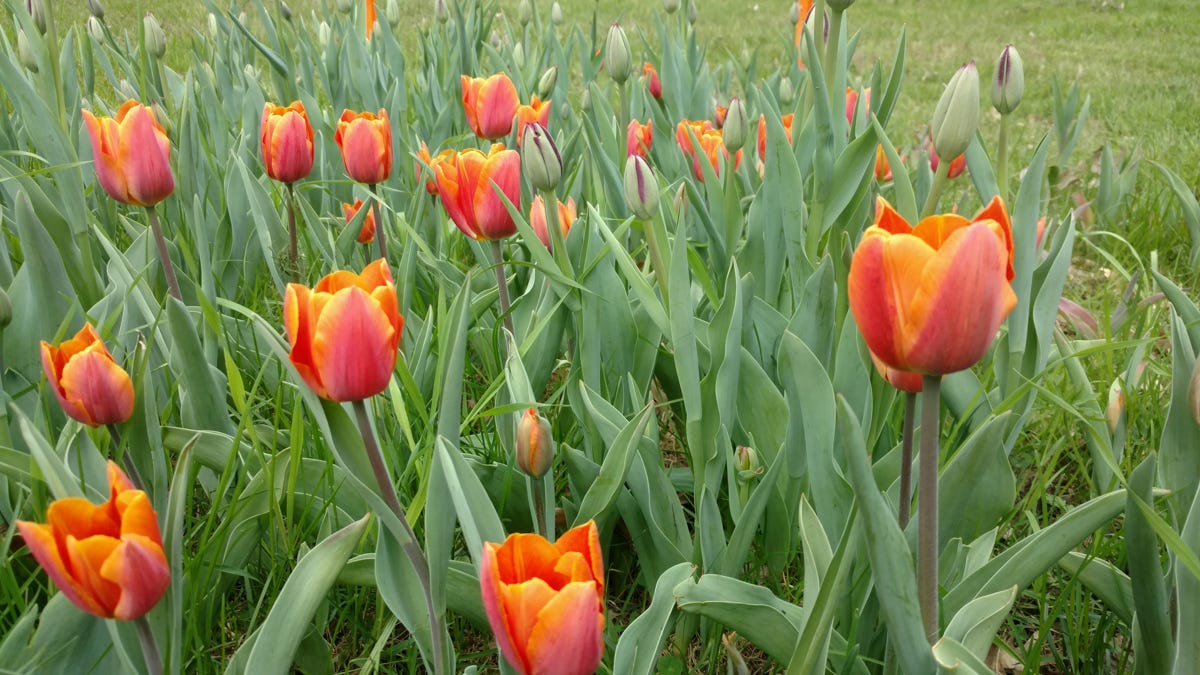
How to Grow Tulips
Tulips, treasured bulbs from Turkey, welcome spring around the world. These members of the Lily family are more varied, versatile and vigorous than gardeners realize and can be early, late, fragrant, fringed, ruffled, striped, double, lily-form, multicolored, festive, formal, and from 4” to 30” tall.
When & Where to Plant Tulips
Tulip bulbs are planted in fall in USDA hardiness zones 7 and below. In Zone 8 and higher plant bulbs in late December or January for spring bloom providing bulbs have been chilled at 40-45°F (a refrigerator works well) for 10 weeks prior to planting.
Light: Tulips grow best in full sun in the North and partial shade in the South.
Soil: Plant tulip bulbs, pointed end up, in well-drained soil with a pH between 6 and 7. Add compost to improve sandy soils and poorly draining clay soils.
Spacing: Plant bulbs 4-6” apart.
Planting: The general rule of thumb is to plant bulbs three times as deep as the bulb’s length. Traditionally, tulips are planted 6-8” deep. Those who favor deep planting at 12”, claim there is less chance of sprouting in fall, damage by cold air and soil, being heaved up by freezing and thawing, or being eaten by animals. Southern gardeners may prefer to plant their bulbs at a more shallow depth, to take advantage of the exposure to cool air that occurs closer to the soil's surface.
Planting Steps:



Be sure to water in thoroughly if planting in dry soil; enough to wet the planting hole and bulb. This will send a clear message to the bulb that it's time to grow.
How to Grow Tulips Throughout the Season
Growth Habit: Tulips grow upright and erect with each bulb producing a single flower on a leafless, node-less stem.
Staking: Most tulip stems are sturdy and do not need staking. However, hybrids with giant flowers can be top-heavy and require support in spring winds and heavy rain.
Watering: To trigger root system growth before winter dormancy, always water bulbs after planting. Since bulbs are susceptible to rot diseases from excess water, normal rainfall should suffice through spring. In a hot, dry spring additional water may be needed to prolong flowering. Irrigation systems are death on tulips. To keep bulbs dry during summer dormancy turn off irrigation systems on bulb beds or lift bulbs out of beds, clean, and store in mesh bag in a cool dry location out of sunlight.
Fertilizing: Fertilize bulbs at planting time in fall and again in early spring when sprouts emerge. Broadcast a 4-10-6 organic bulb fertilizer at a rate of one teaspoon per bulb.
Mulching: Cover the bulb bed with 2-3” of mulch after planting to insulate the soil, maintain even soil moisture, and stop soil from splashing on the flowers.
Trimming & Pruning: Remove spent blooms to prevent seed formation. Allow stems and leaves to die back naturally to yellow or brown before removing them. If leaves are removed while still green, the bulb won’t store enough food to bloom next year.
Tulips: End of Season Care
Dividing & Transplanting: Tulips can be divided every 3-5 years when dormant in fall, taking care not to damage bulbs. When tulips stop producing flowers or leaves emerge smaller than normal, bulbs are hinting that they need more room to grow. Dividing tulip offsets from the mother bulb is one solution. Offsets take several years to reach maturity. Offsets produce exact copies of the parent plant.
After tulips blossom, their energy budget goes to seed production. If you want the tulips to flower next year, removing the developing seed capsules allows the sun to feed the foliage. In turn, the foliage feeds the bulb. Do not cut back foliage until it is completely yellow.

If your goal is to grow tulips from seed, plant a separate plot of tulips just for seed collection. You can propagate many more plants from seed than from bulb offsets and most tulips readily produce seed. Seeds produce surprises.
Pests/Disease: Tulips pests include aphids, bulb mites, thrips, rodents and deer. Control measures are:
- Aphids - squash between fingers or wash off with a water spray
- Bulb mites – inspect bulbs when purchasing for signs of decay, heat treat bulbs in 120°F water for 2 minutes to kill mites
- Thrips – enlist ladybugs and green lacewings to eradicate these sapsuckers, place bright yellow and blue wooden paint stirrers coated with petroleum jelly to trap thrips
- Rodents – cover bulb zone with chicken wire embedded beneath surface; plant bulbs 12” deep; spray bulb or area with deterrents like cayenne pepper, human urine, animal hair; interplant tulips with bulbs rodents won’t eat such as allium, crocus, daffodil, fritillaria, and hyacinth
- Deer – 8” fencing works best
Two serious fungal diseases affecting tulips are tulip fire and grey bulb.
Symptoms include:
- twisted, withered, distorted foliage soon after emergence
- brown spots on foliage
- rot spots on flowers
- fuzzy grey mold on dead foliage
- black seed-like fungal spores on dead zones
Control fungal diseases by inspecting bulb surfaces for signs of decay when purchasing and removing and destroying infected specimens. Do not replant tulips in contaminated site for at least three years. Good air circulation around plants reduces the risk of fungal diseases.
Tulip virus manifests itself in streaked, flamed, or feathered flower petals and distorted growth. Affected bulbs must be destroyed. Control of aphids and thrips reduces disease risk.
To learn more about the plants we sell and how to grow them in your garden beds and patio containers, sign up for our inspiring emails.